#442nd infantry regiment
Explore tagged Tumblr posts
Text

Bill Mauldin’s cartoon, even the most pointed ones, could more readily be called “wry” in their observations than “fucking savage.” But not always.
65 notes
·
View notes
Text










I think Brad was braced for fisticuffs...the first thing I said, as I cautiously approached, was "I'm not Bill!!"
(I nipped out of a nearby film con to pick up @georgetakei 's book for @tonymoy88, who is illustrating the story of the 442nd Japanese-American Infantry Regiment who fought in WW2 while their families were in the internment camps)

#star trek#star trek tos#star trek the original series#captain kirk#jim kirk#james t kirk#james kirk#hikaru sulu#captain sulu#george takei
178 notes
·
View notes
Text
On one hand, only having the Tuskagee Airman in Episode 8 makes sense - the 99th Fighter Squadron, which I think is the one they're portraying, was in Italy until summer 1944. On the other hand, I absolutely understand people being disappointed that they only appear now. On that note, I've been thinking of possible subjects for a POC-focused WWII miniseries. I've got a few ideas - wondering what you think.
This is largely combat unit focused too, so if anyone has other suggestions I'd love to hear them. I am looking forward to that film on the 6888th, hope that's good.
The big one is probably the 442nd Regimental Combat Team, which consisted of Japanese-Americans and was the most decorated combat unit of the war for the United States.
Either the 92nd or 93rd Infantry Regiments, both African-American - the former faced particularly severe racism from their commander, a white supremacist, piece-of-shit and all-round incompetent by the name of Ned Almond.
The 99th Fighter Squadron - they're appearing in Masters of the Air but they deserve their own series.
Any of the African-American tank units at the close of the war.
Literally anything, ever, on the British Indian Army or the Gurkhas. You could complicate this by having some of the characters end up in Bose's INA and others remain with the British.
A miniseries based on the life of Reg Saunders, one of the first indigenous Australian army officers.
And while it's WWI, the Harlem Hellfighters are overdue for onscreen rep.
17 notes
·
View notes
Text
What is up with White WW2 nerds and their cherrypicking of WW2 history? Like, Spielberg is a self-proclaimed WW2 nerd but all the WW2 stuff he's either made or produced are centered primarily on White soldiers. Where's my media telling the stories of the Tuskegee Airmen? The 442nd Infantry Regiment? The Navajo code talkers? What dont yall want to help tell their stories?
14 notes
·
View notes
Text

The 92nd Infantry Division, a military unit of approximately fifteen thousand officers and men, was one of only two all-Black divisions to fight in the Army in WWI and WWII. The 92nd was organized on October 1, 1917, at Camp Funston and included African American soldiers. Before leaving for France in 1918, it received the name “Buffalo Soldier Division” as a tribute to the four Buffalo soldier regiments that fought in the regular Army in the nineteenth and early twentieth centuries.
The soldiers were deployed to the front lines in August 1918. The 92nd saw action in one of the last Allied operations of the war—the Meuse-Argonne Offensive September-November 1918. The 92nd, unlike the 93rd, the other all-Black division in WWI, fought under American command. When WWI ended, the 92nd returned and was deactivated in February 1919.
After the US entered WWII, the 92nd was reactivated on October 15, 1942, and trained at Fort Huachuca with the 93rd Infantry, the other all-Black division. After that training was completed, the 92nd was deployed to Italy while its counterpart was sent to the South Pacific. On July 30, 1944, the first units of the 92nd arrived in Naples, and by September 22, the entire division was stationed in the Po Valley. Assigned to the Fifth Army, the 92nd included the 442nd Regimental Combat Team, both suffered some of the heaviest casualties of the war and became one of the most decorated military units.
The division first saw significant action against German troops and Italian troops in September, and by October, they were engaged in offensive campaigns in the Serchio River Valley and along the coast near the city of Massa. On April 29, 1945, elements of the 92nd liberated the Italian cities of La Spezia and Genoa. They participated in other battles in Northern Italy until May 2, 1945. First Lt. John R. Fox won the Medal of Honor for his action in the Serchio Valley on December 26, 1944, and First Lt. Vernon J. Baker won the medal for his action near Viareggio on April 5–6, 1945. Both medals were not awarded until 1997. The 92nd returned on November 26, 1945, and was deactivated on November 28. #africanhistory365 #africanexcellence
1 note
·
View note
Text
1/422/106-ID - Forced March (Mohn) The Fate of the American POWs of the 106-ID)
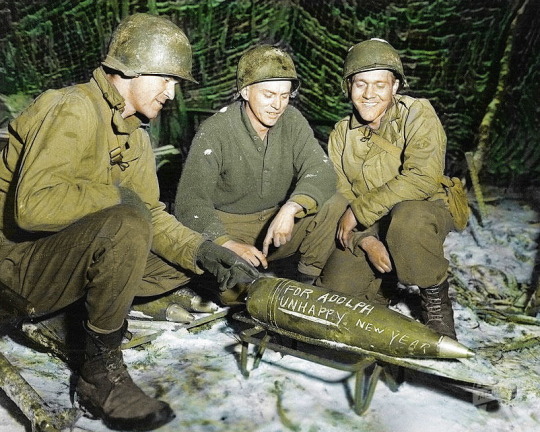
Source Document: Forced March Major John P. Mohn, HQ Co, 1st Battalion, 422nd Infantry Regiment, 106th Infantry Division

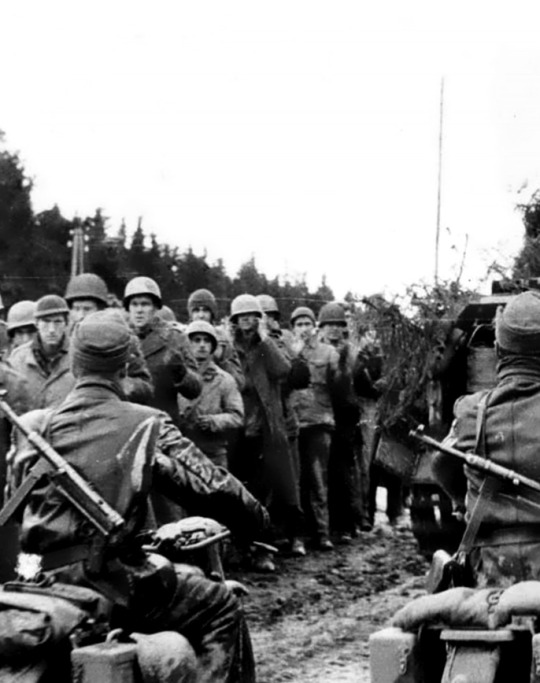
Forced March, from Schoenberg - St Vith (Battle of the Bulge, Belgium) to Berchtesgaden in Germany, is the Prisoner of War memoir of the 1200-mile forced march done by Maj John J. Mohn, Hq Co, 1st Battalion, 442nd Infantry Regiment, 106th Infantry Division, Golden Lion and has been extracted from a book published in Canton, Ohio, USA and printed by PPi Graphics, also in Canton Ohio, (ISBN-13:978-08-9863465-5-2). Being a friend of Mandy Altimus Pond, Maj John J. Mohn's granddaughter, we talked about the publishing of this book on the EUCMH Website and agreed that this work would be a great way to render honor to Maj John J. Mohn and the terrible period he experienced while being one American Prisoner of War in Nazi Germany during the last year of WW-2. Before starting with the text, I would like the reader to notice that combat photos from a surrendered unit in the combat zone don't exist, especially with the 422 and the 423-IRs of the 106-ID. On the morning of Dec 16, 1944, these two infantry regiments, were trapped between two German main axes of penetration; on their front, elements of the 5.Panzer-Army (Manteufeul) coming from Blieaf in Germany and heading to St Vith and on their rear, elements of the 6.Panzer-Army (Dietrich) coming from Lanzerath and Manderfeld heading to Liège via St Vith, didn't give a one of a chance to these two Regimental Combat Teams (422 and 423) which once cut off, without supply, couldn't withdraw in any direction. These men combated up to the last cartridge, then destroyed all their guns, machine guns, and rifles, and finally surrendered. Dedication To my wonderful wife, Cheri, and loving daughter, Debora Mohn Altimus; without whose prodding and encouragement this book would never have been written. And to my son-in-law Richard Altimus who assisted in the computer editing of this book. Editor's Note: Additional thanks to my granddaughter, Mandy Altimus Pond, who helped me with the publishing of her grandpa's book. Maj John J. Mohn, 1/442-IR, 106-ID

Foreword When WW II's Battle of the Bulge began with a surprise German attack on Dec 16, 1944, troops of the US 106th Infantry Division occupied the most exposed American positions. They had been in the European continent for less than two weeks and cut off from reinforcements, were left to face the German onslaught alone. They fought back, standing their ground, but as their ammunition; food and medical supplies dwindled and the enemy noose drew tighter, over 7000 were ordered by their commanding officers to surrender to the surrounding German forces. Except for the Bataan Death March, this was the largest surrender of American troops during WW II. Maj Mohn, of Akron, Ohio, the author of this book, was the Operations Officer of the 1/422-IR. He was a citizen-soldier who had volunteered to join the Army as a private in 1941. This is the story of his 1200-mile odyssey as a prisoner of war to the far reaches of the Nazi empire during which he and his fellow soldiers were starved, frozen, bombed, and shot. Because the Germans were unprepared to absorb a massive influx of American POWs and had little space to house them, Maj Mohn's imprisonment became an almost continuous five-month march through the collapsing and chaotic Third Reich. Initially, he was sent to a camp for American officers over 500 miles away from Poland. He

arrived there only to be marched out of the camp a few days later when the Russian forces broke through the German lines around Warsaw. Seeing the prisoners as a potential bargaining chip and intent on keeping them out of Russian hands, the Germans forced the Americans to make a harrowing march westward across rural Poland and Germany in the dead of winter just ahead of pursuing Soviet forces. After this month-and-a-half ordeal, the prisoners finally arrived at the Hammelburg POW Camp in northern Bavaria, only about 100 miles away from where they started. Two weeks later this camp was attacked and briefly captured by a Task Force of Patton's 3-A. The Germans, however, soon recaptured the camp and immediately sent Maj Mohn and the other prisoners on another dangerous march which ended at the Austrian border five weeks later they were liberated by American troops. Through it all, Maj Mohn preserved and returned to the USA where he underwent treatment and rehabilitation for injuries he had suffered as a prisoner of war. he returned to civilian life and developed a highly successful career as a psychologist. But his remarkable experiences in the military never quite left him. Eventually, he put words to paper and the result is the archive you are about to read - one of the very few accounts of this type ever to have been published. More than just a narrative of his experiences as a POW in Nazi Germany, it is a testament to the indomitable spirit of the US soldiers and a reminder to all of us of the sacrifices they made to preserve our freedom. Before the Battle of the Bulge - Mandy Altimus Pond


About 1937, while attending Akron University, John Mohn took Reserve Officers' Training Corps. John had no desire to become an officer, but by the end of his training, he had reached the rank of 2nd Lieutenant. In preparation for what appeared to be an inevitable world conflict, Congress passed the Selective Service Act in 1940. This was the first peacetime conscription in US history. Enacted in September 1940, this act required men between 21 and 35 years of age to register with local draft boards. Men were drafted by a lottery system and were required to serve for twelve months. After that year was completed, John was told he would be draft-free and not required to sign up, should a war arise. On Feb 4, 1941, John decided to enlist for this program and join the Navy. He drove to Cleveland, entered the Armory, and began the process. He took the written test, passed the physical, and was about to be sworn in when the commanding officer at the Armory said that John's teeth protruded too much and they would not accept him. John stated in an interview that 'this is stupid' and went to the other end of the Armory and enlisted in the Army. At this moment he could have enlisted as a 2nd Lieutenant because of his ROTC training. It slipped his mind and he enlisted as a Private.


John was assigned to the 37-ID at Camp Shelby, Mississippi. He volunteered for the Signal Company (Teletype) and the day after he signed up, the teletype was discontinued, so he was reassigned to supply in the Signal Company and was sent to Indiantown Gap Pa. On Dec 7, 1941, the Japanese attacked Pearl Harbor, and the next day upon request from President Franklin D. Roosevelt, Congress declared war on Japan and their ally Germany. This canceled the draft-free status that John had signed up for, as he had not completed his twelve months of training. His division was scheduled to board a ship headed to the Pacific Theater of the war, but the boat blew up before they could head out.

John was then sent to Fort Benning, Georgia, for officer training from February through April 1942. In late 1942, he was sent to Camp Forest and assigned to the 80-ID for a year. He became CO Fox Co, 1/319-IR, 80-ID. His division was in charge of clearing trees in the mountains in preparation for war games, training men in firing artillery, and surviving in realistic battle situations. John was in charge of the logistics and planning for the war games.
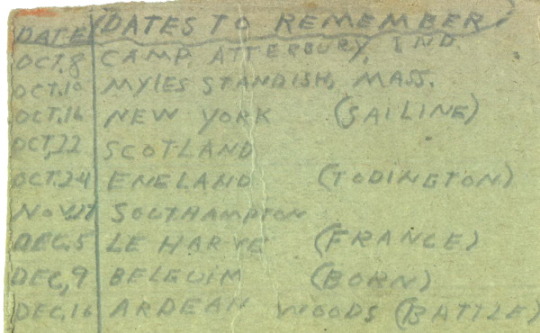
The 80-ID was then incorporated into the 106-ID. John was reassigned as Bn OP Officer and sent to Camp Atterbury, Indiana, and assigned to Hq Co, 1/422-IR, 106-ID. John reached the rank of Captain and was told that he was the youngest Captain in the Division. As Operations Officer, he was in charge of logistics for troop movements. He staged a large 3000-troop parade in Indianapolis in 1944. After our advance movement order was in, we received new equipment, turned in motor vehicles, and did what training we could at odd intervals. Finally, in September we moved by rail to Camp Myles Standish at Taunton, Mass. This place was known as a staging area where life reached the maximum of not letting anyone know anything at all. We existed on a monotonous routine of rumors until the day we redoubled our tracks, returned to New York, boarded the RMS Aquitania, and departed for Gourock, Scotland, on Oct 21, 1944. The 423-IR with various attached units arrived Oct 27, and the 422 and 424-IRs arrived Oct 28 with the artillery and some special units. We moved then to England where we were deployed in one of the most interesting and certainly the most beautiful parts of this country, the Cotswold section of the midlands. The 422-IR was stationed some 12 miles west and northwest of Oxford, the 424-IR near Banbury of Banbury Cross fame, and the 423-IR, and the Division Artillery near Cheltenham and Gloucester respectively. Division headquarters and special units were located centrally in this 200-square-mile area.
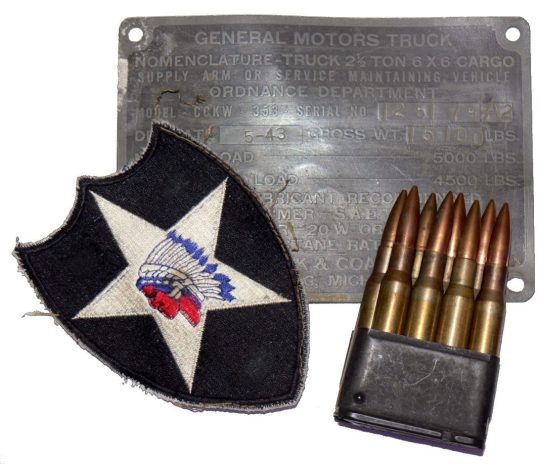
We remained in England preparing for an expected early crossing of the Channel. Between Nov 30 and Dec 1, the Golden Lions embarked on the long slow fifty-mile trip from Southampton to cross the Channel. We disembarked at Le Havre and at Rouen, a town about one-third of the way up the Seine toward Paris, and went into a bivouac in deep mud in the open fields in a cold drizzling rain, between the Dec 1/8.

During these days liaison officers from the 1-A headquarters arrived at odd intervals with conflicting and inconsistent sets of orders, so that during 48 hours we were assigned to three different corps in as many separate locations. Fortunately, troops and staff were arriving in unrelated groups as the weather and the Navy allowed them ashore so that no damage was done except to my disposition. The final messenger appeared on Dec 6 with instructions for us to leave for the St Vith area in Belgium. The first combat team to move, left the area on Dec 8, followed by the others as rapidly as possible. Upon arrival, we were to relieve the 2-ID, then in a defensive position, as part of the VIII Corps whose headquarters was then at Bastogne. Troops being in the throes of landing after a rough winter crossing, staffs only partly present and maps few and far between, our move to the battlefield was a rather remarkable one and highly successful despite its discomfort. The route carried us nearly 300 miles through Amiens, Cambrai, and Maubeuge in France to Philippeville in Belgium. After an overnight bivouac in extra deep mud near the latter town, we passed through Marche and the villages of eastern Belgium to the vicinity of St Vith, arriving during the period Dec 9/15. The relief of the 2-ID's weary troops stationed along the quiet German border in the Belgian Ardennes Forest commenced on Dec 11, and was completed on Dec 13, responsibility for the defense of the sector passing to me on Dec 12. The troops of the Indian head Division assured the men of the Golden Lion Division that there would be little action on this hilly terrain in the middle of winter. Edward P. McHugh

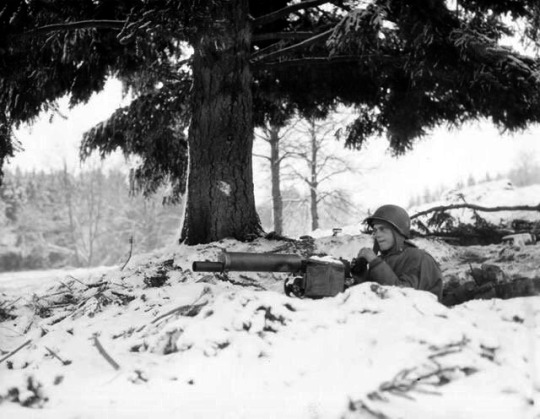
Preface - Maj John J. Mohn It was Dec 16, 1944, somewhere along the Siegfried Line near St Vith, Belgium. The German counter-attack that would later be referred to as the Battle of the Bulge had begun. The gray, foggy dawn made a perfect umbrella for the German launching of an onslaught that nearly cost the Allies World War Two. What happened at the Battle of the Bulge may be a well-known story but none of the stories make any reference to the group of American Soldiers taken prisoner at that time and marched for 140 continuous days covering over 1200 long, cold, starvation-ridden, nightmare miles, terminated only by the end of the war in Europe. Adversity is a mild term to describe the unbearable hardships endured by the ever-changing, ever-diminishing column of men. Temperatures dropped to ten degrees below zero (22°F). There were periods of fifteen days without a single bite of food. All suffered a phenomenal loss of weight (I weighed 65 pounds by the time of the liberation). We had inadequate clothing; many were without hats or gloves and at times no shoes. It was especially brutal for the poor Army Air Corpsmen who were only wearing thermal boots with no soles for walking when they were shot down and captured. The journey was marked by frozen feet, legs, arms, faces, and even blood trails. Treachery, deceit, and fear are just feeble attempts to put into words the anger, horror, anguish, and despair felt by these military men.

The ordeal that the approximately 7000 US soldiers endured between Dec 16/44 and May 2/45 can only be epitomized by saying that a scant thirty of the original group even reached liberation as a unit. Losses of men beyond belief resulted from attempts at escape, exposure, starvation, the sadism of the German Guards, and being strafed daily by our own and Allied planes. My book is not intended as a condemnation of the German People or Army but does make reference to differing attitudes and treatment by the Wehrmacht, to whom I owe a debt of gratitude for being alive, and the Elite SS Troops, who were constantly threatening our lives with attempts to exterminate us with machine guns and failed to provide even the most basic of necessities for our daily maintenance. The German High Command seemed at a loss as to what to do with so many prisoners and lacked a plan regarding the disposition of us. The result was a wandering march covering three countries with no apparent purpose, with a final goal of holding us as hostages in Berchtesgaden at the end of the war. The consequences for us, as Prisoners of War, were painfully clear. The facts and sequences of events I know first-hand because I was there from the beginning to the end. I saw dramatic changes in attitudes, values, behavior, and beliefs. Hidden strengths and weaknesses in the struggle for survival were surprising and at times frightening, but the salient factor through it all was that survival is 'All-Important' and that the 'Veneer of Civilization' is extremely thin.

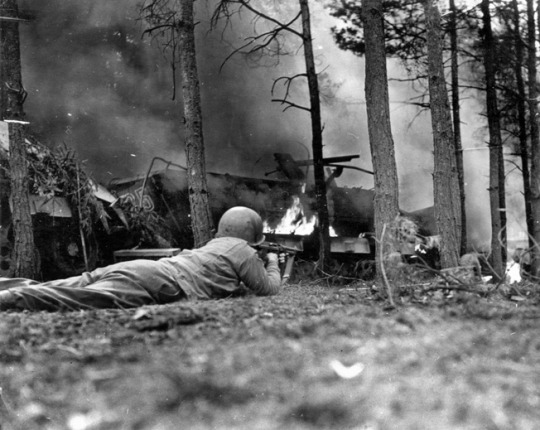
December 16, the Horror Begins I couldn't help being reminded of that famous poem by Rudyard Kipling 'The Charge of the Light Brigade' on that fateful, foggy, grey, cold, drizzling morning Dec 16, 1944. The difference was that instead of 'cannons' noted in the poem, we had German tanks to the left of us, tanks to the right of us, tanks in front of us, and tanks behind us. To 'charge' ahead would have been to go down the steep slope of an evergreen-covered mountain. The landscape was so much like the mountain areas of Pennsylvania that it was hard to remember that we were in a foreign country fighting a very serious war. Even more seriously, we were surrounded and annihilated by German Panzer Divisions from the left and right of us. German artillery from the front was terrible enough but, to our dismay, the Germans had captured our artillery and were using our guns to fire upon us from the rear. When we called for supporting fire, they were aiming at us instead of their troops. Our Battalion Commander, Col Thomas Kent was killed by a shell coming in from the rear of our 'Pillbox' command post. At first, we thought our artillerymen were firing short of their target, but when we heard the German voice on our radio, we realized the awful truth - we were literally at their mercy. The divide-and-conquer strategy used in the German attack had been completely unexpected and effective. Read the full article
#106thInfantryDivision#28thInfantryDivision#2ndInfantryDivision#3-A(US)#422ndInfantryRegiment#5.PA(German)#6.Panzer-Army#80-ID(US)#9-AD(US)#Afron#BalticSea#BataanDeathMarch#BattleoftheBulge#Belgium#Berchtesgaden#Bleialf(Germany)#CampMylesStandish#CampShelby#DeboraMohnAltimus#December1944#EdwardP.McHugh#Falkenberg#Fatherland#FortBenning#GenAllanW.Jones#GenevaConvention#Germany#HammelburgPWCamp#HQsCo1/422#IndiantownGap
2 notes
·
View notes
Text
And yet this doesn't seem to apply to certain categories, like the black units who have served throughout US history, or the 442nd Regiment composed of Japanese-American men in WWII.
The 442nd is the most decorated Army unit in US history, with tons of purple hearts, medals of honor, and other decorations. They had enough replacements from the number of losses they had that you could have replaced it twice. Yet this unit is not common knowledge. Nor is it common knowledge why it was made; tons of west coast Japanese Americans were interned in 1942 for fear they might be saboteurs, even if they had never been to Japan, didn't even speak Japanese, and were as loyal and all american as anyone. This included entire families, including a child named George Takei. No German or Italian people were interned. Even if you don't study wwii, you recognize Eisenhower, Pearl Harbor, and D-Day. Yet the 442nd is not well known.
They were at one point attached to the 92nd Infantry Division, a black division, who were reportedly less than stellar in their performance, yet it is likely that that was misreported due to structural racism.
Also ignored is the fact that 10% of the US Army in the US Civil War was black. In fact, people go so far as to claim black soldiers fought for the confederacy, despite documents from their leadership literally saying that that would betray their entire cause of literal slavery. Despite how much they contributed to the war effort, no matter if they were freedmen or former slaves, they are ignored. They fought in the battle of the crater, where many died in part because of racist treatment getting them there. They were decorated with many medals, and suffered greater losses than the proportion of white soldiers. At the Battle of Fort Pillow, Nathan Bedford Forrest, future founder of the Ku Klux Klan, wrote a note demanding Fort Pillow's surrender, that ended with saying there would be "No mercy". The largely black garrison was then slaughtered. It made big news. Lincoln condemned it. Black soldiers were poorly treated in POW camps, many being carted off as escaped slaves. Slavers would regularly walk in to examine them, and you can bet many lied and said "this one is mine". The entire POW exchange system during the war broke down because of these men. Normally, prisoners could be exchanged over the course of the war. The rebs refused to treat black men as soldiers, and the Union said they wouldn't trade anyone period if those men weren't given basic rights. The manpower-starved rebels decided they would rather treat these prisoners badly than get any more of their captured idiots back. Despite that danger, these men fought valiantly, to the point that black regiments continued to exist after the war, up until the army was desegregated in 1947. And despite this, the war is depicted as brother against brother, white man vs white man. You know the 20th Maine, you know Gettysburg, you don't know the "5th United States Colored Cavalry"(yes that was the official designation, the word was not seen as offensive at the time)
Further, historical slaves are not considered American in popular history, they're seen as people who needed to be freed. They are not seen as our fellow countrymen in bondage, they're described as black people first, slaves second, and Americans a distant third. You see people ask why they didn't want to leave the country afterwards. Ask yourself, why would someone want to leave their native country? Lots of people hate what their home countries do, but still stay. Asking that question, and unwilling to ask the same of white people, kinda implies one doesn't view slaves as American. Many of the slaves had been there for generations. They are just as American as the Irishmen who got off the boat ten years before the war. Yet still people see them as somehow separate. Popular narratives see them as other at best, as kidnapped foreigners at worst. Popular history wants to see them as "not us", as something different, horrified that the US did this to 12% of its own people.
Yes, in 1860, 12% of the country was enslaved. 3 out of every 25 people in the US were enslaved. 1/3rd of the population of Virginia was slaves.
Yet somehow, popular narratives continually set slaves apart. The war is still seen as white man vs white man. A tacit support of the Lost Cause narrative claiming it was States' Rights.
The Irish, Italians, Germans, and basically most Eastern Europeans were not seen as American or even white for a lot of US history. That perception changed in the latter half of the 20th century. Attitudes toward Asian people changes depending on the day.
Yet when it comes to these sorts of contributions...even if seen as American they are a footnote.
I think it’s so interesting how once American minority groups get credit for ANYTHING they’ve done or created someone chimes in, suddenly insistant that they are Americans, the minority identity doesn’t matter anymore because they are AMERICAN and this is an American accomplishment for all Americans to claim.
13K notes
·
View notes
Video
youtube
"Go for broke"
A song about the 442nd Infantry regiment during World War 2. The regiment is best known as the most decorated in U.S. military history and as a fighting unit composed almost entirely of second-generation American soldiers of Japanese ancestry (Nisei) who fought in World War II.
Sung by Judo Club at 21 Pell St, NYC 10013
0 notes
Text
Nisei, From Internment to Infantry. Today is Pearl Harbor Day
We had the great pleasure of attending a screening this past week of Nisei. “Nisei” follows the harrowing journey of brothers Minoru and John Miyasaki as they are stripped ofcitizenship, imprisoned, and then ultimately volunteer to join the 442nd Regimental Combat Team, an allJapanese-American regiment and the most medaled unit in the history of the US military. Visit our instagram for…
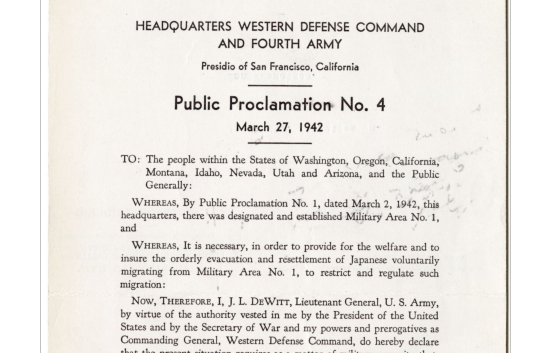
View On WordPress
0 notes
Text
100th Infantry Battalion Valor and Sacrifice in World War II
100th Infantry Battalion Valor and Sacrifice in World War II
The 100th Infantry Battalion/442nd Regimental Combat Team, also known as the “Purple Heart Battalion” or the “Go for Broke” regiment, was a highly decorated unit composed primarily of Japanese American soldiers during World War II. In this blog post, we will explore the remarkable story of the 100th Regiment, highlighting their bravery, sacrifices, and the significant impact they made on the…

View On WordPress
0 notes
Note
Flowers, what are your thoughts on the 442nd Infantry Regiment?
well I'm googling them right now if that tells you anything
I didn't know this regiment existed. most of what I've read about Japanese-Americans in wwII focused on life in the internment camps and didn't talk much about these guys. it's interesting that they apparently popularized the term "go for broke" which was previously Hawaiian slang people on the mainland didn't know about
0 notes
Text
Jan Beneš o neznámé historii japonských Američanů za Druhé světové války

O vysídlení sto tisíc japonských Američanů do sběrných táborů po Pearl Harboru víte. Ale věděli jste, že za armádu pak v segregovaném pluku bojovalo 10 tisíc japonských Američanů? Získali rekordní počet ocenění, zvítězili v jedné z nejtvrdších evropských bitev.
Pluk s označením 442nd Regimental Combat Team vznikl v únoru 1943. Tvořili jej japonští Američané 2. generace, ale velitelem a nejvyššími důstojníky byli běloši. Dvě třetiny vojáků pocházely z Havaje (ta nebyla státem). V pluku byli dělostřelci, pěchota i kapela a zdravotníci.

Připravovali se v Camp Shelby v Mississippi, v té době v Evropě působil Stý pěchotní prapor, segregovaná jednotka japonských Američanů.

Pluk byl po výcviku přesunut do Itálie a v srpnu 1944 byl k němu připojen právě Stý prapor. Jejich heslem se stalo Go for Broke, Riskuj všechno.

Na podzim 1944 se podíleli na spojenecké invazi Francie, osvobodili městečka Bruyeres and Biffontaine od nacistů. A pak dostali volno, které jim však zrušili, protože se ve Vogézách „ztratil“ prapor 275 texaských vojáků, které se nedařilo Spojencům osvobodit z německého obležení.

Část japonsko-amerického pluku proti 6 tisícům německých vojáků bojovala 5 dní a osvobodila 211 Texasanů. Přišli přitom o 800 vojáků. Velení šokovala jejich chrabrost i počet vojáků, o něž při záchranné misi přišli. Texaský guvernér hrdiny v roce 1962 jmenoval čestnými Texasany.

Japonští Američané následně osvobozovali severní Itálii, tentokrát po boku segregovaných afroamerických pěchotních jednotek. Celkem 442. pluk získal 4 tisíce Purpurových srdcí, 4 tisíce bronzových hvězd, 560 stříbrných hvězd, 21 Medals of Honor (nejvyšší vyznamenání).

Vojáci ve 442. pluku byl mnohdy dobrovolníci, chtěli dokázat věrnost USA, navzdory pochybnostem o loajalitě jap. Američanů. Například Sadao Munemori, který padl v Itálii, působil v armádě už před Pearl Harborem a sloužil i když jeho rodina trpěla v americkém internačním táboře.

442. pluk taky byl u osvobozování koncentračního tábora Dachau.

V pluku rovněž sloužil Daniel K. Inouye, který od roku 1959 sloužil jako první federální kongresman za Havaj, od roku 1962 jako vůbec první senátor z nejnovějšího státu Unie.

Někteří vojáci z 442. pluku získali ocenění za chrabrost hned po 2SV, zbytek si na ně musel počkat až do roku 2010, kdy Kongres schválil zákon oceňující celý pluk. V roce 2012 je ocenila i francouzská vláda. Jedná se o nejvíce vyznamenanou jednotku americké armády v dějinách.

Květen je Asian American and Pacific Islander Heritage month, takže jsem na toto téma narazil na tw profilech pár amerických historiků. Jinak zdroje hír a na youtube je toho hodně:
Patriots Under Fire: Japanese Americans in World War II
by Kathryn Shenkle, Historian, Arlington National Cemetery
EUROPEAN THEATER OF OPERATIONS 100/442D REGIMENTAL COMBAT TEAM
Fifty years later, the "Remember Pearl Harbor" 100th Infantry Battalion, and the "Go For Broke" 442d Regimental Combat Team is still the most decorated unit in U.S. military history. Members of this unit earned over 18,000 individual decorations including 9,486 Purple Hearts, and 5,200 Bronze Stars. The Combat Team earned five Presidential Citations in 20 days of Rhineland fighting, the only military unit ever to claim that achievement. General of the Army George C. Marshall praised the team saying, "there were superb: the men of the 100/442d... showed rare courage and tremendous fighting spirit... everybody wanted them." General Mark W. Clark (Fifth Army) said, "these are some the best... fighters in the U.S. Army. If you have more, send them over." This World War II unit was composed of up to 4,500 nisei, which means second generation Americans of Japanese ancestry. ⬇️
Going For Broke: The 442nd Regimental Combat Team
The 442nd Regimental Combat Team, a segregated Japanese American unit, is remembered today for its brave actions in World War II. Despite the odds, the 442nd’s actions distinguished them as the most decorated unit for its size and length of service in the history of the US military. ⬇️
Asian-Pacific Americans in the U.S. Army 442d Regimental Combat Team
The 442d Regimental Combat Team (RCT) was activated on 1 February 1943, composed of American-born Japanese called "Nisei" (NEE-say), or second generation. Some volunteered from Hawaii, others from the ten relocation centers on the mainland. The commander and most company grade officers were Caucasian; the rest of its officers and enlisted men were Nisei. The team included the 442d Infantry Regiment with three battalions, the 522d Field Artillery Battalion, and the 232d Engineer Company. After a year of individual and unit training at Camp Shelby, Missippi, the unit deployed to the Mediterranean in May 1944. The 1st Battalion remained at Camp Shelby to train replacements and was redesignated the 171st Infantry Battalion (Separate).
Autor článku a odkazů: Jan Beneš ⬇️
0 notes
Text

Original caption: "Camp Shelby, Mississippi. Japanese-American Combat Team. At Camp Shelby, Miss. Americans of Japanese ancestry from California, Hawaii, and other areas are undergoing intensive training as an Army combat team. One group of Japanese-Americans has already gone and seen action in the Mediterranean Theatre. These pictures show some of the phases of the training of the 442nd Combat team at Camp Shelby: Chaplain (Lt.) Masoa Yamada, Hawaii, junior regimental chaplain of the 442nd Infantry, the first person of Japanese ancestry to be commissioned a Chaplain in the U.S. Army reporting to Col. C.W. Pence, Commanding Officer of the Japanese-American Combat Team at Camp Shelby, Mississippi. 1943."
0 notes
Text
Speculative Fiction, or Alternate History - AltHist - has always been a favourite read of mine. The art of taking off from a fixed point in history to diverge into an imaginative flight of "what if?" and then either choosing to merge it back again with the original timeline or let it flow into a parallel one gives a writer so many possibilities that when well written, it's a treat for the readers to follow them on the journey
#1945#Robert Conroy#alt history#book review#world war 2#world war second#blog post#books & libraries#writing#speculative Fiction#alternate history#442nd Infantry Regiment
10 notes
·
View notes
Photo






Fighting On Film: Go For Broke! (1951)
In this episode of Fighting On Film we examine 1951's 'Go For Broke!', written & directed by Robert Pirosh and starring Van Johnson - who had worked together on 'Battleground' (FoF Episode 6). The film tells the unique story of the 442nd Infantry Regiment, a US Army unit made up of Japanese-Americans who became the most decorated unit of its size of World War Two!
youtube
The episode is also available on all other podcast platforms, you can find them here.
Thanks for listening!
#Fighting On Film#Go For Broke!#War Movie#War Movie Podcast#War film#442nd Infantry Regiment#442nd Regimental Combat Team#Japanese-American Troops#Second World War#Podcast#WW2#WWII#World War Two#US Army#Classic Movies#Van Johnson
62 notes
·
View notes
Text
Why we don't have a WWII movie about the 442nd is beyond me.
10 notes
·
View notes